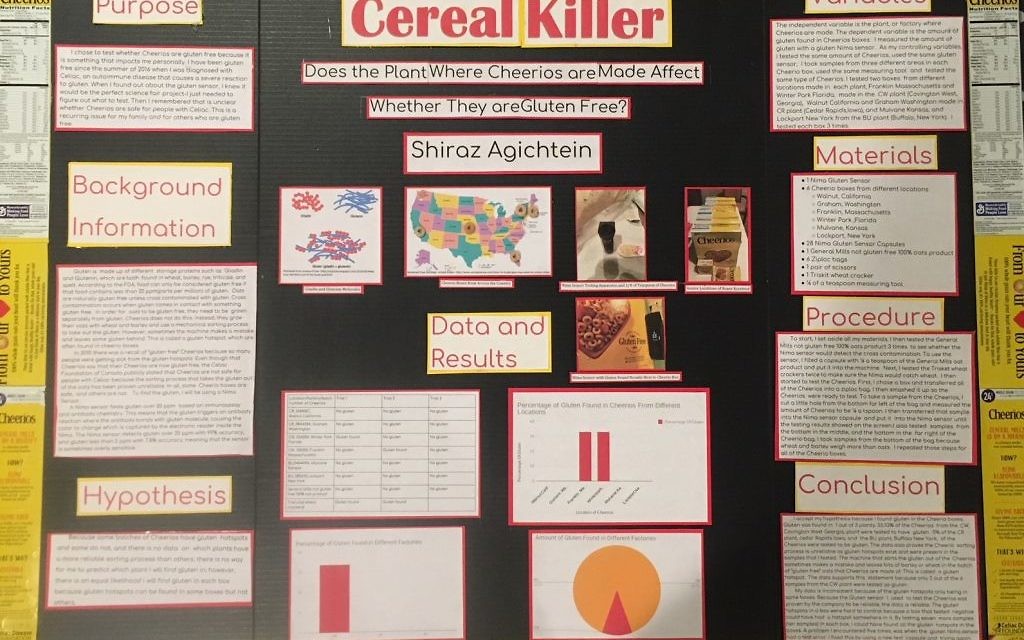8th-Grader’s Celiac Warning: Gluten in Cheerios
Atlanta Jewish Academy student Shiraz Agichtein's science fair project tests samples from three factories.

An Atlanta Jewish Academy eighth-grader with celiac disease applied science to her medical condition and found that Cheerios aren’t safe for her and others who are allergic to gluten.
“Even people who are actually gluten-sensitive should not be eating Cheerios because I didn’t just find cross-contamination,” Shiraz Agichtein said in an after-school phone interview. “I found actual pieces of gluten, and that doesn’t just affect people with celiac, but it affects people with wheat allergies or people who are just a little bit gluten-sensitive.”
For a science fair project, Shiraz, 13, used a Nima sensor, which detects gluten, to see whether Cheerios lived up to the gluten-free promise on the cereal box. General Mills had recalled the cereal in 2015 because so many people were having reactions to gluten hotspots — places where the mechanical sorting fails to remove gluten that gets into the oats from wheat or barley grown nearby.
Get The AJT Newsletter by email and never miss our top stories Free Sign Up

Under pressure from the Canadian Celiac Association, General Mills removed “gluten-free” from its Canadian boxes this year.
Shiraz was diagnosed with celiac only two years ago, said her mother, Shoshana Dayanim. Shiraz said she had suffered a range of health problems from age 5, including that she wasn’t growing at the normal rate.
Trusting the label, she kept eating Cheerios after her diagnosis until a nutritionist told her not to. “I never really understood why, so I thought a good idea for my project is to explain to myself why and also to prove whether they’re actually safe or not.”
But she didn’t just go to Kroger or Publix and buy a box of cereal. She wanted to see whether contamination varied among the plants producing Cheerios, so her mom made a request on a celiac Facebook group for people to send boxes. She got boxes from Massachusetts and Florida, both produced in Covington, Ga.; California and Washington state, both from a plant in Cedar Rapids, Iowa; and Kansas and New York, both manufactured in Buffalo, N.Y.
She tested each box three times, crushing the cereal in its plastic bag, then cutting holes in three places to draw an eighth of a teaspoon of cereal for the Nima sensor.
She credits AJA science teacher Suzanne Sears with helping her turn her ideas into a workable project.
“There’s never been an experiment like this, so I had no idea whether I would find gluten and from which factories,” Shiraz said. “I assumed I would find gluten because the sorting process has been proven unreliable.”
She found gluten hotspots in two boxes — the two from the Georgia plant. She hasn’t contacted General Mills or visited the plant to talk about her findings, but she said she’d like to.
“I don’t know if it means that the plant is more heavily contaminated than the other plants,” Shiraz said. “It’s possible that I just didn’t find the gluten hotspots in the other boxes.”
What she did find impressed the judges at the regional Fulton County and Georgia science fairs. At the regional level, she was first overall and first in her category of biomedical health sciences, and she was nominated for Broadcom MASTERS recognition. At the state level in late April, she won an award from the University of Georgia’s nutrition department for helping keep families healthy and received an invitation to present her project at the Tellus Science Museum this summer.
“The only negative” from the judges, Shiraz said, “was to take off the glue strands on my poster.”




comments